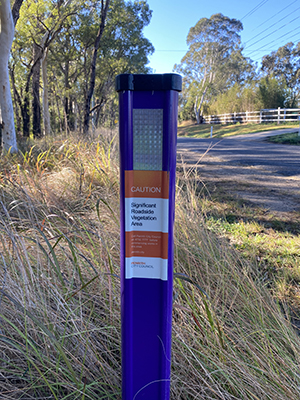Roadside Vegetation
- Details
- Written by: Teela Griffin Penrith City Council (02) 4732 7777 (02) 4732 7958 council@penrithcity.nsw.gov.au https://www.penrithcity.nsw.gov.au 601 High St Penrith NSW 2750 Australia
 Roadside environments and the conservation values present within the road reserve vary considerably. In the rural and peri-urban areas of the Penrith Local Government Area (LGA), vegetation occurs in patches of variable size and is often highly fragmented. This increases the importance of roadside vegetation as steppingstones between remnant patches. Remnants provide valuable wildlife habitat and support areas of core habitat when linked to other vegetation across the landscape.
Roadside environments and the conservation values present within the road reserve vary considerably. In the rural and peri-urban areas of the Penrith Local Government Area (LGA), vegetation occurs in patches of variable size and is often highly fragmented. This increases the importance of roadside vegetation as steppingstones between remnant patches. Remnants provide valuable wildlife habitat and support areas of core habitat when linked to other vegetation across the landscape.
Roadside vegetation is a prominent part of the landscape and provides public amenity and aesthetic value. Well-structured native vegetation with trees and shrubs provides shelter from road noise, dust and prevailing winds and shade for residents and others using the roadside environment.
Penrith Council has implemented a Roadside Vegetation Management Plan (RVMP). In preparing the RVMP, 567 kilometres of roadside within the peri-urban and rural areas of the LGA were assessed. Roadside environments were assessed using the Roadside Assessment Method developed by Local Government NSW and Local Land Services. Results of the assessment show 140.2 kilometres were considered to have High Conservation Value (HCV) and 42.3 kilometres with moderate conservation Value (MCV).
The majority of vegetation communities within the roadside reserve are listed as threatened ecological communities under both state and/or federal legislation and, as a result, these areas hold significant conservation value. These areas provide potential habitat for many native plants and animals, including 56 threatened species such as the Powerful Owl, Regent Honeyeater and Southern Myotis.
Most of the native vegetation within Penrith that is naturally occurring along roadside reserves is part of the Cumberland Plain Woodland, listed as a critically endangered ecological community.
Roadside reserves contain valuable environmental assets that provide habitat for native flora and fauna and amenity to local communities. As a result, the need to manage roadside reserves for environmental objectives and recognise the ecological value of these areas across the LGA rather than exclusively for their utility as transport corridors has emerged.
The RVMP also outlines several key threats to native vegetation and biodiversity that Council takes into consideration. These include
- Dieback
- Invasive weeds
- Clearing
- Slashing/ underscrubbing
- Littering/ dumping
- Frequent burning
- Firewood removal
- Roadside construction and maintenance
- Stockpiles
- Infrastructure building and maintenance
Council will be complementing the assessments from the RVMP by installing purple roadside markers where High Conservation Value vegetation or threatened species have been identified and require protection. No work is to be permitted by Council, contractors or the community without an environmental assessment being undertaken by a qualified person.
For more information on Roadside Vegetation Markers check out our FAQ.

